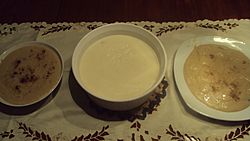Manjar blanco facts for kids

Colombian "Manjar Blanco" (center bowl)
|
|
| Alternative names | Manjar de leche, manjar |
|---|---|
| Type | Dessert |
| Region or state | Europe, Americas and Maritime Southeast Asia |
| Main ingredients | Milk |
Manjar blanco is a yummy sweet treat made mostly from milk. People in Spanish-speaking countries use this name for different kinds of milk-based desserts. You might also hear it called manjar de leche or just manjar.
In Spain, manjar blanco is a dessert called blancmange in English. It's a jiggly, sweet dish found in many parts of Europe. But in the Americas, especially South America, manjar blanco is a sweet, white spread or a filling for pastries. Sometimes, people confuse it with dulce de leche or cajeta. These are similar but made a bit differently. Other countries have their own versions, like tembleque in Puerto Rico. In countries where people speak Portuguese, it's known as manjar branco.
Contents
What is Manjar Blanco in Spain?
In Spain and other parts of Europe, manjar blanco is a dessert that looks a bit like gelatin. It's often made in a mold. Long ago, in the Middle Ages, this dish was made with chicken or fish, rice, sugar, and milk. It was likely inspired by Arab cooking. Today, in Spain, the main ingredients are milk, almonds, corn starch (to make it thick), or gelatin, and sugar.
Manjar Blanco in South America
In countries like Peru, Ecuador, Chile, and Argentina, manjar blanco is a sweet, thick spread. It's made by slowly cooking pure milk and adding sugar. Sometimes, people add other flavors like vanilla, citrus juice, cinnamon, or even rice.
To make it, people often use a special cooking pot called a double boiler. This helps the mixture cook slowly without turning brown. The final result is a white or cream-colored spread. It's thick, like frosting for a cake, but tastes more like sweet cream. The way it's cooked is similar to how sweetened condensed milk is made, but manjar blanco is much thicker.
You can use manjar blanco like jelly or jam on toast. It's also very popular as a filling for pastries and cookies. For example, it's often used in alfajores and tejas cookies.
Manjar Blanco in Central America
In countries like Guatemala and El Salvador, manjar de leche is a type of pudding or custard. It's made with milk, cornstarch (to make it thick), sugar, and often flavors like vanilla or cinnamon. This white dessert can be eaten by itself or used to fill pastries.
In Costa Rica, the word "natilla" means a special kind of sour cream. It's used as a topping for dishes like gallo pinto (a rice and beans dish), baked potatoes, or steamed vegetables.
Manjar Blanco in Colombia
Manjar blanco is a traditional Christmas dish in Colombia. It's often eaten during the holidays along with another sweet treat called natilla. It's made from milk, rice, and sugar. These ingredients are cooked for a long time until they get the right thick texture.
Colombians usually enjoy manjar blanco with a slice of natilla, some buñuelos (fried dough balls), and hojuelas (crispy fried pastries). The salty taste of the buñuelos goes really well with the sweet desserts. You can find manjar blanco in stores all year, but it's especially popular around Christmas.
Manjar Blanco in the Philippines
In the Philippines, there's a similar dessert called maja blanca. The main difference is that it uses coconut milk instead of regular milk. Sometimes, it also has corn kernels in it, and that version is called maja blanca con maiz.
See also
 In Spanish: Manjar blanco para niños
In Spanish: Manjar blanco para niños

